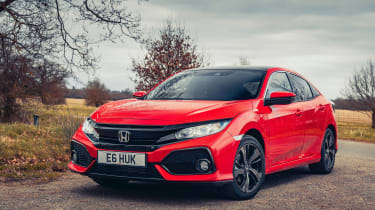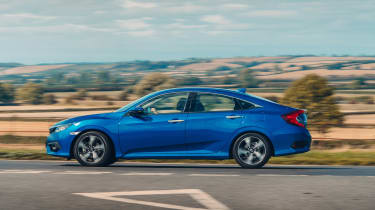Honda Civic review (2015-2022) – ride and handling
It’s clear the Type R has had a positive effect on the standard Civic’s handling, but a mini Type R this is not
The way the Civic actually drives is hugely competent but not generally that much fun. That’s not to damn the Civic with faint praise – those seeking thrills will undoubtedly go for the Type R, and anyone trading up from cooking versions of the current Civic will find a great deal to like about the new car.
Among its merits are quick steering (but not to the point of nervousness), strong grip levels and foolproof balance. The ride quality is impressive, although standard cars are on much more conservative wheel sizes than the crazy Type R.
> Click here to read our review of the Honda Civic Type R
The steering is light and transmits very little feel, but on dry, smooth tarmac it’s predictable enough to commit to corners with confidence. Traction is very good – though not hugely troubled by the current engine range – and lifting off the throttle mid-corner tucks the nose in safely but doesn’t call the rear axle into play. This is a stable car, rather than an agile one.
Honda has finally seen fit to return to fully independent rear suspension, something that disappeared when the eighth-generation model debuted. There are struts up front, as before, but the rear is now multi-link. The reason back then was to maximise boot space; the reason now is to improve the way the car drives. The 1.5-litre models have the option of adaptive dampers.
What is clear is the effect the Type R has had on the standard Civic models. Although it’s not quite as playful as the new Focus, or refined as a Golf, it does have an inherently sophisticated feeling in how it goes down the road, never feeling like the chassis is getting away from you no matter how hard you push. It feels like it’s from the class above, in much the same way the Type R doesn’t feel like a hatchback, rather an extremely well sorted front-wheel-drive performance car.





